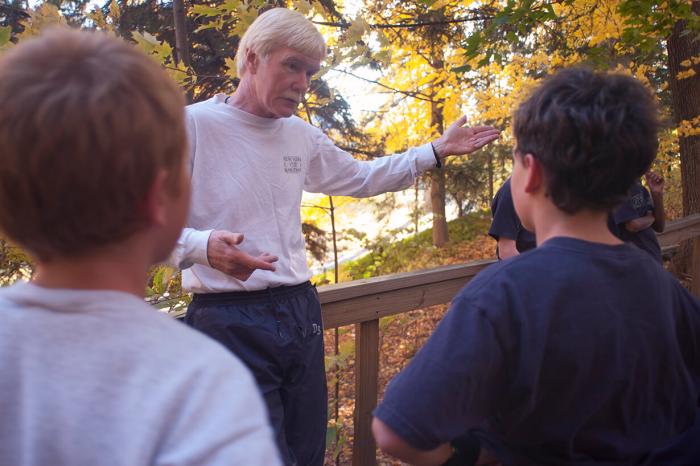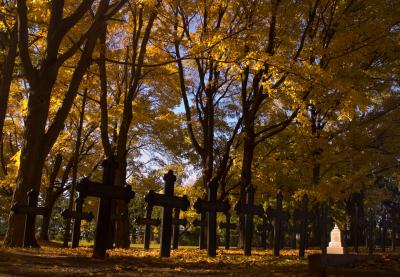Seamus Hodgkinson shows a disfigured bullet to his class. His middle-school students watch with rapt attention. He's teaching a lesson in tolerance. "Terrorism is not new since 9.11," he says. "I grew up with terrorism."
Hodgkinson teaches in Albany, N.Y., but was raised in Northern Ireland during "The Troubles," a time of religious unrest and violence. There were shootings and bombings nearly every day. Thousands of lives were lost as hatred between Catholic and Protestant groups escalated into intense battles. One horrible night, the air filled with putrid smoke as firebombs erupted on Hodgkinson's street. He and his family huddled helplessly in the back of the house as explosions crashed and windows shattered.
The bullet Hodgkinson shows his class is one that had lodged in the rafters of his Belfast attic.
The Wall Goes Up
In 1969, in an effort to ease the violence, British troops began erecting 30-foot-high brick walls topped with barbed-wire, separating Catholic and Protestant neighborhoods. This Peaceline -- a term Hodgkinson describes as "misnamed" -- snakes along the lanes of tidy row houses and runs for miles through major parts of Belfast.
The massive wall successfully segregated the people. Most of his Catholic friends had never even met a Protestant. They lived in their own neighborhood, went to their own school and played their own sports. "And on the other side of the wall," he says, "the Protestant kids were going to their school, then back to their own neighborhood and never met a Catholic."
Hodgkinson, however, was exposed to both religions. His family home sits squarely where the opposing sides meet. The wall severs the end of his street with a pair of military-green blockades locked with heavy metal chains. The only way to get to his house is through a small pedestrian gate cut into the side of the wall. The gate is monitored and locked at the first sign of trouble. He remembers walking down the street to the store and returning to find he had been locked out. The wall remains today.

Education Without Walls
Hodgkinson left Northern Ireland in 1975 to accept a teaching position at the newly formed Doane Stuart School in New York. This was the first successfully merged Catholic/Protestant school in the country. Being offered a job there couldn't have been a coincidence. "I had come from a situation where Catholics and Protestants were killing each other, and here was this school bringing them together," he says.
And it was happening without violence.
Hodgkinson longed for this tolerance in his beloved Ireland. But how could they even learn about each other when divided by bricks and barbed wire? If only he could tear down that wall. As a teacher in America, however, what could he do?
A seed of an idea formed in Hodgkinson's mind. What if he could bring students from Belfast -- both Catholic and Protestant -- to experience his school in America? "I felt we must take this dream that we've built here and offer it back to a place that needed it desperately."
School administrators supported his idea, but staff changes, indecision, confusion, red tape and lack of funds caused delays. He received $1,000 in seed money from a private donation, but it sat untouched for years. Hodgkinson worried he was wasting hard-earned money on what may have amounted to only a dream. More than 10 years passed, but Hodgkinson never gave up. He was convinced his plan could work.
Living With the Wall
As Hodgkinson was struggling with his dream, Tony and Sam were attending separate high schools in Belfast. They each had been chased by kids from the other side of the wall and seen their friends beaten for being the "wrong" religion. They were aware of the consequences of walking in wrong parts of the city and wearing their school colors where they shouldn't. When they learned about an Irish Exchange Program in the United States, they were intrigued. Both applied.
In 2002, Hodgkinson welcomed the boys -- one Catholic and one Protestant -- to America for the school year. Tony and Sam lived with host families and discovered new places and new foods. At Doane Stuart School, they participated in classes, played basketball and attended interfaith chapel services with all the other students. Hodgkinson felt that a pebble had been cast; surely it would create ripples. He hoped the boys would return to Ireland with a new acceptance and understanding.

I had come from a situation where Catholics and Protestants were killing each other, and here was this school bringing them together.
Today, with the program in place for two years, four Belfast students have experienced life and education, and been introduced to new ideas, in America. Hodgkinson anticipates the program will grow to include more Irish students, and that Doane Stuart students will be able to complete the exchange by visiting Belfast.
The Wall Begins to Crumble
In 2005, Doane Stuart's Irish Exchange Program won the Leading Edge Award for Equity and Justice from the National Association of Independent Schools.
Despite the program's success, there still were times when Hodgkinson wondered if bringing a couple of kids to America for a year would really make much of a difference. It wasn't until he returned to visit Ireland in 2003 that he saw its full impact.
That summer day he walked up the steps of the neat, cream-colored brick house of one of the program's first students. Tony cheerfully welcomed him. "There's a few people here I'd like you to meet," Tony grinned. "These are the students coming to your school next year."
Hodgkinson looked around the comfortable living room at the students and their families sitting on the sofas, chatting.
Then he realized what he was seeing.
It was one thing for Tony and Sam to have been together in America; here, however, were Catholics and Protestants gathered peacefully at a house in Northern Ireland. He smiled as he thought of that forbidding wall. Hodgkinson couldn't tear it down all by himself, but deep inside he felt it starting to crumble.
